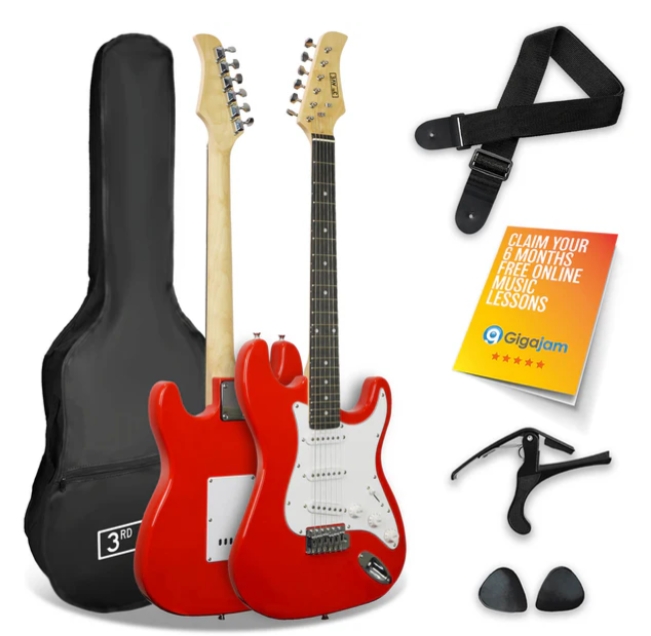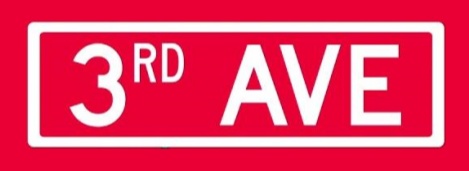
3rd Avenue Full Size Electric Guitar
- Full size electric guitar in an ST style
- Perfect for any beginner aged 11+
- Maple neck and redwood fingerboard
Everything You Need to Know Before Buying a 3rd Avenue Electric Guitar
The 3rd Avenue electric guitar has become an extremely popular choice for beginner and intermediate guitarists looking for a high-quality, affordable electric guitar. With so many options, features and specifications to consider when shopping for a 3rd Avenue electric guitar, it can be tricky to know which model is right for your needs and budget. This comprehensive buying guide covers everything you need to know before purchasing a 3rd Avenue electric guitar, from build quality and sound to price ranges and accessories.
What is the Overall Quality of 3rd Avenue Electric Guitars?
3rd Avenue offers well-crafted electric guitars that deliver impressive sound and performance capabilities considering their very reasonable price points. They are designed to be high-quality, yet budget-friendly instruments that do not compromise on playability, tone or looks. Most models feature a solid wood body, usually made from basswood, maple or alder. The hardware, including tuning machines and bridges, is generally durable and smooth functioning. Attention is also paid to the fretwork and electronics.
For beginners, the build and sound quality is extremely impressive for the low cost. Intermediate players will also find 3rd Avenue electric guitars can deliver great tone and sustain while avoiding many of the issues found in cheaper guitars. The quality control and construction standards allow these guitars to play and sound like more expensive models.
Overall, 3rd Avenue electric guitars provide amazing value for money. While not at the same tier as premium guitars from elite brands, they outperform most other instruments in their price range. The quality is suitable for new players, while still meeting the needs of more advanced musicians on a budget.
What is the Price Range of 3rd Avenue Electric Guitars?
3rd Avenue electric guitars are primarily aimed at the entry-level and mid-range price points, making them ideal for beginners and intermediate players. Here is an overview of the typical pricing:
- Entry-level models – $80 to $200: The most affordable 3rd Avenue guitars include the Squire, Stratocaster and Les Paul style models. These are basic, no-frills electric guitars perfect for beginners.
- Mid-range models – $200 to $400: Step up to guitars like the 3rd Avenue Deluxe and Classic for better build quality, electronics and hardware. Great for intermediate players.
- Premium models – $400 to $600: Top-of-the-line 3rd Avenue guitars have premium features like flamed maple tops, Seymour Duncan pickups and Grover tuners. Offer exceptional value in their price range.
While you can find 3rd Avenue guitars outside of these price ranges, most models fall within the affordable entry-level to mid-tier pricing. This makes them very cost-effective electric guitars for those shopping on a budget. Paying more gives you upgraded components and ornamentation while the core build quality remains high.
Are 3rd Avenue Electric Guitars Good for Beginners?
3rd Avenue guitars are excellent choices for beginner electric guitarists for the following reasons:
- Affordable pricing – Beginner-friendly pricing makes it easy to buy your first guitar without overspending.
- Quality components – From the wood to the pickups, bridges and machine heads, 3rd Avenue uses quality parts that withstand learning and practicing.
- Playability – Low action, smooth frets and comfortable neck shapes make learning chords and scales easy.
- Lightweight – Many models are lightweight for comfort and portability.
- Variety of styles – From Stratocasters to Les Pauls, 3rd Avenue offers all the classic guitar shapes beginners want to learn on.
- Good sound – Pickups and electronics allow beginners to get decent tones for learning and playing.
- Upgradability – Start with a basic 3rd Avenue then mod it later as your skills improve.
With their combination of quality, playability and affordability, 3rd Avenue electric guitars remove many of the barriers for beginners. You get professional components, comfortable playing feel and impressive sound without hitting wallet too hard.
Where Can I Buy a 3rd Avenue Electric Guitar?
3rd Avenue electric guitars are sold through various online and offline channels:
- Amazon – Excellent selection of 3rd Avenue guitars available on Amazon. All the major models are represented and Prime shipping available.
- Online music stores – Sweetwater, Musician’s Friend, Guitar Center and Sam Ash all carry 3rd Avenue electric guitars.
- 3rd Avenue website – Buy direct from 3rd Avenue’s online store. Get customization options.
- Mass retailers – Walmart stores stock a variety of 3rd Avenue electric guitars.
- Specialty shops – Some local music stores may carry 3rd Avenue electrics. Call your local retailers.
- Used marketplaces – Find deals on used 3rd Avenue guitars on Reverb.com, eBay and Craigslist.
For the biggest selection and easiest purchasing, buying a 3rd Avenue electric guitar online through Amazon or mass retailers is ideal for most buyers. You can also check 3rd Avenue’s website or local music stores for particular models not widely available.
Key Features and Specs of 3rd Avenue Electric Guitars
3rd Avenue guitars offer great quality and value thanks to smartly chosen components and construction. Here are some of the most important features and specifications to look for:
- Woods – Basswood, alder and maple are commonly used in 3rd Avenue guitars. These tonewoods provide balanced sound.
- Neck – Most models have maple necks while higher end guitars may have 3-piece maple/mahogany necks for enhanced stability.
- Fretboard – Rosewood and maple fretboards are common. Some models have ebony for smooth playing feel.
- Frets – Medium-sized frets preferred by most players. Some guitars have jumbo frets.
- Scale length – 25.5 inches is standard. Allows comfortable playing and tight string tension.
- Tuners – Die-cast and locking tuners hold tuning accurately through heavy playing.
- Pickups – Quality pickups from Seymour Duncan, EMG and in-house brands give great rock tone.
- Controls – Master volume and tone plus 1-3 pickup toggles provide tonal versatility.
- Bridge – Tremolo or fixed bridges with solid string locking design and smooth tuning stability.
Carefully inspecting these hardware and component details helps find the 3rd Avenue electric guitar best suited to your needs and budget.
How Do 3rd Avenue Guitars Compare to Other Brands?
When compared to other major electric guitar brands like Fender, Epiphone and Ibanez, 3rd Avenue guitars hold up very well in terms of quality, playability and value:
- Beginner guitars – Exceed Squier, Epiphone Les Paul 100 and Ibanez GIO starter packs in quality while costing much less.
- Intermediate guitars – Rival Mexican Fenders, Epiphone 400 PRO series and Ibanez RG in looks, feel and performance at lower prices.
- Materials used – Use the same basswoods, maples, alders found on models from other brands. Pickups and hardware also comparable.
- Attention to detail – Fretwork, tuning stability and electronics on par with major brands. QC ensures reliable performance.
- Sound and playability – With quality parts and smart design, 3rd Avenue guitars play and sound like more expensive big name models.
While not a premium American-made guitar, 3rd Avenue instruments compete with leading brands favorably while undercutting them significantly on cost. You get impressive value without sacrificing quality control or components.
What Amp Should I Use with a 3rd Avenue Electric Guitar?
A good amplifier matched to your guitar and music style makes all the difference. Here are top amp recommendations for pairing with a 3rd Avenue electric:
- Beginners – Fender Mustang LT25, Vox Pathfinder 10 and Peavey Vypyr VIP 1 are affordable, versatile modeling amps perfect for learning.
- Intermediate players – Step up to a Fender Hot Rod, Vox AC15 or Peavey 6505 for more power and advanced features.
- Guitarists on a budget – The Fender Champion 20 offers basic amp modeling effects in a very inexpensive package.
- Versatile clean/crunch tones – A Vox AC30, Fender Hot Rod Deluxe or Boss Katana 50 provides sparkling clean headroom plus overdriven growl.
- Heavy rock and metal players – Choose a high gain amp like the Peavey 6505+ or EVH 5150 III for thick, saturated distortion.
- Tube amp purists – Check out the Fender Blues Junior or Vox AC15 for classic tube warmth and organic crunch.
Take your time deciding on an amp that matches your skill level, budget and sound needs. A modeling amp offers the most versatility for new guitarists while tube amps provide organic tone for experienced players.
What Accessories Come with 3rd Avenue Electric Guitars?
3rd Avenue packages most of their electric guitars with useful accessories to help new players get started:
- Gig bag/case – All models include a padded gig bag or hardshell case. Protect and transport your guitar.
- Strap – A 2″ wide nylon strap comes standard for playing standing up. Higher end models may include leather straps.
- Picks – A variety of plastic pick thicknesses are included to experiment with.
- Cable – A 10′ instrument cable connects your guitar to the amp.
- Tuner – An electric tuner makes tuning fast and precise. Clip-on chromatic tuners common.
- Spare strings – Extra sets of strings are handy when old strings break or wear out.
- Polishing cloth – Gentle cloth for wiping down and cleaning the guitar finish.
Some packages may also add things like a pickholder, whammy bar, thumb drive of lessons/songs and extra tremolo springs. Convenient accessories remove hassle for new players.
How Do I Tune a 3rd Avenue Electric Guitar?
Tuning a 3rd Avenue electric guitar is simple if you follow these steps:
- Plug into tuner – Using the included clip-on tuner, plug the guitar directly into the tuner using the cable provided.
- Tune low to high – Start with the low E string. Play the string and turn the appropriate tuning peg to match the E tone on the tuner’s display.
- Check tuning pegs – Tuning peg tension should be taut but not too tight. Loosen any stiff pegs.
- Tune each string – Go through each string from the A string on up to the high E string, playing then tuning until the display matches.
- Fine tune – Play through each string again slowly and make micro-adjustments to perfect the tuning.
- Check tuning periodically – As you play, check tuning every 10-15 minutes and make quick tuning tweaks as needed.
- Change strings regularly – Replace old strings every few months for easier, more stable tuning.
Take your time tuning patiently and accurately. Checking tuning frequently will become a habit before playing. Changing strings regularly makes staying in tune much easier.
What Size and Weight Can I Expect from a 3rd Avenue Guitar?
3rd Avenue electric guitars are designed with comfortable size and weight specs suitable for most players:
- Body thickness – 1 5/8″ to 2″ body thickness is common. Enough thickness for solid wood tone without being bulky.
- Body shapes – Strat, Tele, LP and SG style bodies balance comfortably on a strap or lap.
- Weight – 6 to 9 lbs is average. Heavier guitars have mahogany or maple, lighter have basswood or alder.
- Scale length – 25.5″ scale length adds tension and stability while allowing easy fingering.
- Neck profile – Thinner, flatter neck profiles typical for comfortable chording and fast playing.
- Fretboard radius – Usually a modern 9.5″ – 14″ fingerboard radius for low, fast action.
- Frets – Medium wire frets preferred by most players. Some guitars have jumbo frets.
The sizes and weights allow comfortable playing whether sitting or standing, and the contours and radii make chords and solos easy for most hand sizes. Overall, well balanced for playability.
What 3rd Avenue Electric Guitar Models Are Available?
3rd Avenue offers an extensive lineup of electric guitar models covering all the most popular styles:
- Stratocaster guitars – Available in Standard, Deluxe, HSS and HH pickup configurations just like Fender Strats. Top choice for versatility.
- Les Paul guitars – Classic singlecutaway design with humbuckers for thick, sustaining rock tone.
- Telecaster guitars – Crisp, twangy tone and reliable performance. Great country/pop guitars.
- Super Strat guitars – Shred-friendly guitars with exotic shapes, Floyd Rose trems and hot pickups.
- SG guitars – Lightweight, fast playing guitars ideal for hard rock and metal.
- Hollow/semi-hollow guitars – Hollowbody jazz boxes and f-hole guitars offer acoustic resonance and feedback.
- Signature models – Imitate your heroes with guitars copying Eddie Van Halen, Slash and other legends.
- Left-handed guitars – Full lefty model lineup mirrors the righty versions.
No matter your style or influences, 3rd Avenue has a guitar model sure to fit your needs at an affordable price.
How Durable Are 3rd Avenue Electric Guitars?
While priced low, 3rd Avenue electric guitars meet quality control standards that make them quite durable instruments:
- All-wood construction – Basswood, alder and maple bodies withstand bumps, humidity and temperature changes.
- Damage-resistant finishes – Tough polyurethane, nitrocellulose and basswood finishes resist chips and scratches.
- Hardware – Rugged bridges, tuners and other hardware withstand string tension and handling.
- Fretwork – Smooth, rounded fret ends properly set into the fretboard avoid chipping and tangling.
- Neck joints – Set, bolt-on and neck-through neck joints maintain integrity over years of playing.
- Electronics – Quality pots, switches, jacks and output jacks function reliably.
Assuming reasonable care is taken, beginners can learn on a 3rd Avenue without concern of damage during the learning process. The materials and components used resist wear and tear well. Just be sure to keep it in the included case when not playing.
Are 3rd Avenue Guitars Good for Professional Use?
While 3rd Avenue guitars are primarily designed for beginners and intermediate players, they can also work well for professional guitarists:
- Recording – Provide excellent clean and overdriven tones when recording in the studio. Hold tuning nicely.
- Gigging – Roadworthy construction withstands the rigors of frequent transport and performance. Stage-worthy looks.
- Backup guitar – Makes an affordable, quality backup guitar for pros to have as a spare.
- Students – Professionals who teach can recommend 3rd Avenue guitars to students for quality and value.
- Modding platform – Easy to upgrade pickups, tuners, etc. to customize the guitar later for pro use.
- Budget gigs – Provides professional sound and performance without having to risk damaging more expensive instruments.
The main downside is that the resale value is low, so pros should be aware of that. Overall, with some minor upgrades and proper handling, a 3rd Avenue electric guitar can absolutely be used for professional studio work, gigging and teaching.
What Do Reviews Say About 3rd Avenue Guitars?
3rd Avenue guitars consistently earn very positive reviews praising their quality and value:
- Impressive for the price – Many reviews state these play and sound as nice as guitars double the price or more.
- Great for beginners – Lots of reviews mention these are perfect starter guitars for new players that exceed entry-level quality.
- Quality components – Reviewers often cite the solid hardware and electronics as being surprising for such an affordable instrument.
- Nice finish – The fit, finish and coating on most models draws positive reviews. Holds tuning well even under heavy playing.
- Easy playability – Smooth necks, low action and comfortable contours make these very playable instruments.
- Good sound – Provides clear, rich tones that lend themselves well to practice and playing a wide variety of musical styles.
While a few reviews mention minor finish or setup flaws, most agree the quality far exceeds the low prices. Ideal for student and budget-minded intermediate players.
How Should I Clean and Maintain a 3rd Avenue Guitar?
Basic maintenance keeps a 3rd Avenue electric guitar looking, playing and sounding its best:
- Clean with soft cloth – Wipe down the strings, fretboard and body regularly with a microfiber polish cloth to remove dirt, oil and grime.
- Proper storage – Keep the guitar in the included case when not playing to protect from bumps, spills and temperature/humidity extremes.
- Check electronics – Inspect pots, jacks, pickups etc. Use electronic cleaner spray to prevent crackling.
- Tuning stability – Keep strings fresh and check neck relief to improve tuning stability. Stretch strings when new.
- Fretboard conditioning – Clean and hydrate rosewood and maple fretboards periodically with lemon oil or conditioners.
- Adjust truss rod – Have a guitar tech adjust the truss rod as needed to match string gauge and playing style.
- Avoid harsh cleaners – Never use alcohol, solvents or abrasives to clean a 3rd Avenue guitar.
With proper storage, regular wipe downs and basic maintenance, a 3rd Avenue electric guitar will offer years of top performance and sound quality.
Are 3rd Avenue Guitars Good for Intermediate Players?
As players improve past the beginner stage, 3rd Avenue electric guitars can absolutely keep up with intermediate players’ developing skills and needs:
- Playability – The neck shapes, action and fretwork allow smooth lead playing with minimal buzzing or fretting out.
- Sound – The pickups and electronics provide versatile tones – from clean and warm to aggressive distortion.
- Looks – The range of finishes and body shapes have the cool looks gigging guitarists want.
- Hardware – Tuning stability from quality bridges, tuners and nuts helps avoid frustration.
- Upgradability – Intermediate players can swap out pickups, tuners, etc. as desired to customize their tone.
- Gigging – Durable construction and reliability make these suitable for weekend gigs and local shows.
- Value – Intermediates on a budget get great bang-for-buck without having to buy the most expensive instruments.
A 3rd Avenue electric guitar won’t hold you back as your skills progress thanks to quality components, rich sound, reliable performance and upgradability down the road.
What Materials Are Used in 3rd Avenue Guitars?
3rd Avenue utilizes quality tonewoods and hardware materials to provide great sound and durability:
- Body woods – Basswood, alder, mahogany, maple and poplar bodies offer balanced, resonant tones.
- Neck woods – Maple is most common, with mahogany and rosewood also used, depending on model. Stable and strong.
- Fretboards – Rosewood and maple fretboards withstand heavy playing. Some models have ebony.
- Frets – Nickel silver, nickel alloy or stainless medium frets offer smooth playability.
- Nut – Graph Tech Tusq is common for precise string spacing and sustain.
- Tuning machines – Die cast or locking tuners keep tuning stable. Name brands like Grover.
- Bridges – Chrome or black tremolo, hardtail and stop tail bridges. Some Floyd Rose trems on high end models.
- Pickups – Alnico humbuckers and single coils from brands like EMG, Seymour Duncan and DiMarzio.
Attention to quality materials throughout provides the resonant tones and reliability intermediate players need.
How Does the Sound Quality Compare to Other Brands?
Overall, the 3rd Avenue electric guitar sounds on par with major brands’ similarly priced models. They are well suited to a wide range of musical genres and playing applications:
- Clean tones – Warm, bright and articulate clean tones comparable to Squier, Epiphone, Ibanez, etc.
- Overdriven tones – Responsive crunch and singing lead tones. Takes pedals well.
- Acoustic resonance – Solid wood construction provides excellent sustain and resonance.
- Sound craftsmanship – Quality materials coupled with precision manufacturing yields great sound.
- Electronics – Dependable pickups and electronics replicate tones of pricier brands.
- Hardware – Quality hardware maximizes sustain and tuning stability for reliable tone.
- Playability – Easy, comfortable playing feel enables better technique and sound.
While not an elite American-made guitar, the 3rd Avenue models compete very favorably on sound quality with brands like Fender, Gibson and PRS in this price range.
What Comes in the 3rd Avenue Electric Guitar Starter Packages?
To help new players get started, many 3rd Avenue electric guitars come in starter packs bundled with useful accessories:
- Guitar case – Padded gig bag or hardshell case for safe storage and transport
- Strap – 2″ nylon guitar strap for playing standing up
- Cable – 10′ instrument cable for connecting guitar to amp
- Pick sampler – Variety of pick styles and thicknesses
- Tuner – Clip-on chromatic tuner for quick tuning
- Extra strings – One or two extra sets of strings
- Picks – Multiple celluloid picks
- Polish cloth – For wiping down strings and body
- Instructional DVDs – Lessons to learn techniques
- Whammy bar – For guitars with tremolo bridges
- Gig bag tags – ID tags to mark gig bag
- Thumb drive – Jam tracks and songs to play along to
The starter packs provide everything a new guitarist needs to start playing right out of the box, all in one convenient bundle. Great value for beginners.
Are Left-Handed 3rd Avenue Models Available?
For left-handed players, 3rd Avenue thankfully offers full left-handed versions of all their most popular guitar models:
- LP-style guitars
- Strat-style guitars
- Tele-style guitars
- Semi-hollowbody guitars
- SG-style guitars
- Super Strat guitars
- Signature guitars
The left-handed configurations have the strap button placement, nut slant and body contours reversed to better fit southpaw players.
Some less common models like acoustic-electrics may only be available in right-handed versions. But overall, lefties have plenty of excellent 3rd Avenue electric guitars to choose from spanning many styles.
The same quality components are used in the left-handed models as the right-handed equivalents. So left-handed guitarists can enjoy low prices without sacrificing playability or sound.
Conclusion
For beginning and intermediate players seeking quality, value and reliable performance, 3rd Avenue electric guitars make excellent choices. Models with versatile tonewoods, name brand pickups and rock-solid hardware provide impressive playability and sound at very wallet-friendly prices. Careful construction and quality control result in guitars that exceed expectations and allow new players to progress without limitations. Just be sure to clean and store your 3rd Avenue properly. With the right amp and care, a 3rd Avenue can go from the practice room to the big stage.





